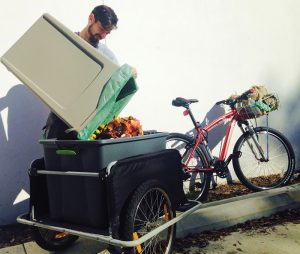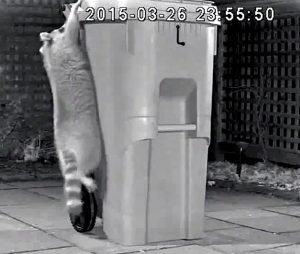BioCycle May 2015
Ellicott City, Maryland: The [Compost] Plot Thickens
Spring has sprung at the Turf Valley Country Club (TVCC) in Ellicott City, home to compost demonstration plots established as part of the BioCycle East Coast Conference at the Turf Valley Resort in October, 2014. The two test plots are comparing standard treatment for turf establishment to “suburban subsoiling,” i.e., the combination of soil decompaction and compost amendment to restore healthy soil profiles in disturbed compacted urban soil. Stuart Schwartz of the Center for Urban Environmental Research and Education at the University of Maryland, Baltimore County, and Charlie Ulevich, Director of Golf Course and Grounds Maintenance at TVCC, led the collaboration to install and monitor the plots.
 BioCycle just received early spring pictures of the two demonstration plots from Schwartz, along with this explanation: “You may recall that the standard treatment plot initially germinated faster and had deeper greener turf, while the complete cultivated compost-amended plot was a little slow in catching up. Both looked great for the conference. This spring, the trend is reversed — the treated plot is greening up sooner with a noticeably denser, more verdant turf. I’d like to believe we’ve got deeper, denser roots in a deeper soil profile, in which plant available nitrogen is not limiting as soil bacteria continue to remineralize the organic nutrients from the compost. … We haven’t done field work there yet this spring, but we want to measure above ground dry mass, and extract roots from shelby tubes later this spring/summer.” Stay tuned!
BioCycle just received early spring pictures of the two demonstration plots from Schwartz, along with this explanation: “You may recall that the standard treatment plot initially germinated faster and had deeper greener turf, while the complete cultivated compost-amended plot was a little slow in catching up. Both looked great for the conference. This spring, the trend is reversed — the treated plot is greening up sooner with a noticeably denser, more verdant turf. I’d like to believe we’ve got deeper, denser roots in a deeper soil profile, in which plant available nitrogen is not limiting as soil bacteria continue to remineralize the organic nutrients from the compost. … We haven’t done field work there yet this spring, but we want to measure above ground dry mass, and extract roots from shelby tubes later this spring/summer.” Stay tuned!
Toronto, Ontario: Racoon Battle Heats Up
Toronto is escalating the battle between residents and racoons, with City Council set to approve a $24.7 million contract for new critter-proof Green Bins for its residential source separated organics collection program. “’We are ready. We are armed. We are motivated to show that we cannot be defeated’ by ‘Racoon Nation,’” a smiling Mayor John Tory proclaimed as he showed off a prototype of the proposed bin, to be made by California-based Rehrig Pacific Company. “Defeat is not an option.” The 10-year contract would include 500,000 bins for immediate free distribution and 50,000 for later needs. At 22.7 gallons, the bins are more than twice the size of the current models. But their main feature is a black latch that must be turned with a circular motion to lock and unlock the container, something that racoons, which have five fingers but lack an opposing thumb, can’t manipulate — at least, for now.
Despite the mayor’s mock wartime tone at a news conference, the high price the city is willing to pay for the new bins demonstrates that racoons are a serious nuisance for its otherwise successful Green Bin program, which sends more than 123,000 tons/year of residential source separated organics to a new municipally-owned anaerobic digester. The city will soon have even greater capacity when its 10-year-old digester is refurbished (see “Toronto Expands Anaerobic Digestion Of Source Separated Organics,” February 2015).
The racoon population in Toronto is estimated at up to 100,000. The city’s many ravines, back lanes, old garages and abundant food sources provide excellent habitat for racoons — so lush, in fact, that a recent study determined the creatures are suffering from obesity, heart disease, high blood pressure and other ailments associated with a life of too much ease. Green Bin contents are among their preferred menu items, and the stiff latches on the current containers are usually no match for them. But in city-run tests, three prototypes stymied racoons that worked hard, but failed, to break into them. Suzanne MacDonald, an animal behavior scientist at Toronto’s York University, did her own tests, putting roast chicken into the prototypes. Even working 10 at a time, racoons couldn’t solve the new bins. “They are smart, but we have big brains and they have small brains,” she says. “If they get into our garbage, it’s our fault.”
City Council’s public works committee recently approved the Rehrig Pacific bid, which the full council is to vote on this month.
Orlando, Florida: Food Scraps Collection And Community Composting
Compost Orlando, a food waste collection and composting service started last year by Alex Stringfellow and Katie Shannon, epitomizes the do-it-yourself, grassroots ethos of community composting. Rather than motorized vehicles, the part-time entrepreneurs use bicycles pulling carts to collect food waste from local residences and businesses. The enterprise grew out of an urban planning graduate school project that Stringfellow and Shannon completed last year at Rollins College in Winter Park, Florida. The community-based project involved developing an ecodistrict in the Audubon Park neighborhood, and introducing food scrap collection and composting, among other sustainable practices.
 Stringfellow and Shannon started in an area of about 1.5 square miles, picking up food waste weekly or biweekly from about 10 local residences and a half-dozen offices and restaurants. Collection is available to families in the Audubon Park, Colonialtown and Baldwin Park neighborhoods and costs $20 a month. Residents outside those neighborhoods can sign up to drop off their food waste for $9 a month on a designated day at three locations in Audubon Park. Compost Orlando uses repurposed, 3-to-5 gallon plastic buckets that once held pickles, baking supplies or other restaurant food items to collect residential food scraps. The collection buckets carry the Compost Orlando logo and are accompanied by information on “why you should compost” and “composting dos-and-don’ts.” Commercial customers are given 23-gallon Slim Jim containers; larger restaurants use 32-gallon Toters. All receptacles are cleaned out and lined with new compostable bags each time the food scraps are transported.
Stringfellow and Shannon started in an area of about 1.5 square miles, picking up food waste weekly or biweekly from about 10 local residences and a half-dozen offices and restaurants. Collection is available to families in the Audubon Park, Colonialtown and Baldwin Park neighborhoods and costs $20 a month. Residents outside those neighborhoods can sign up to drop off their food waste for $9 a month on a designated day at three locations in Audubon Park. Compost Orlando uses repurposed, 3-to-5 gallon plastic buckets that once held pickles, baking supplies or other restaurant food items to collect residential food scraps. The collection buckets carry the Compost Orlando logo and are accompanied by information on “why you should compost” and “composting dos-and-don’ts.” Commercial customers are given 23-gallon Slim Jim containers; larger restaurants use 32-gallon Toters. All receptacles are cleaned out and lined with new compostable bags each time the food scraps are transported.
Composting is done in bins at four community gardens and one “overflow site” at a greenhouse restoration project in the nearby town of Eatonville. The bins are made of wood and metal hardware cloth, roughly four by eight feet and three feet high. The porous hardware cloth has proven an ideal solution for allowing air to pass through the bins, Stringfellow notes. Wood chips, sawdust and other wood waste, along with pine straw and shredded paper, are used as carbon sources, mixed with food scraps in a 2:1 ratio. Producing finished compost takes about two months in summer, and two to five months in winter. Compost is screened to a quarter-inch size; material larger than a quarter inch is added back to the compost pile for innoculation. Doing the processing by hand ensures “zero contamination,” Shannon says. “It can be labor-intensive but we’re at the site so often it’s a once-a-week maintenance thing.”
Compost is used at the community gardens and in urban agriculture programs. Food waste service customers receive finished compost in 2- and 3-pound bags. Compost Orlando is collecting about 300 to 400 lbs/week of food scraps. Florida’s humid and rainy climate creates some composting challenges, Stringfellow notes. “We’ve learned the importance of proper layering techniques so the material doesn’t get bogged-down.” Much of Compost Orlando’s marketing has been done by word of mouth, along with social media tools including Facebook and Instagram. And the neighborhood info sites, Nextdoor.com and Bungalower.com, “have been pretty phenomenal in helping establish customers,” notes Shannon, who also does outreach at community events.














